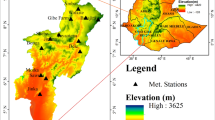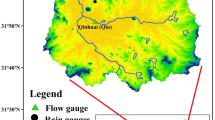Abstract
Afghanistan, as a landlocked country located within central and southwestern Asia, has an arid to semi-arid climate. Most of the people are involved in agricultural activities, and a major part of the country’s gross domestic product depends on agriculture, but the country has the lowest water storage capacity. Consecutive periods of drought and rapid snowmelt due to climate change have made it more challenging for suitable water resource management practices. This study investigates the historical meteorological drought characteristics across the whole country by employing the Reconnaissance Drought Index for the period 1979–2019 using data from 55 meteorological stations. Trends in precipitation and temperature are also investigated using the Mann-Kendall’s and the Sen’s slope statistical tests. A four-decadal countrywide drought map is generated. Extreme and severe droughts were observed in 1999 and 2000 across the whole country. Moderate drought events have started to occur with a frequency of 3 to 5 years since 1999. The decadal annual rainfall values in each river basin indicate that rainfall has decreased in the last two decades with a significant decline in 1999-2008. The trends of increase in temperature and decrease in precipitation are indications of rapid climate change in the country, especially in the south, west, and southwest regions. Due to the intensity and frequency of the droughts, river flow rates have decreased; and therefore, there is a need for the upstream and downstream neighboring countries to come to terms with the phenomenon of a new normal in the hydrological cycle and accordingly revise new water sharing treaties.









Similar content being viewed by others
References
Ahmad M, Wasiq M (2004) Water resource development in northern Afghanistan and its implications for Amu Darya Basin. In: World Bank Working Paper, No. 36. World Bank, Washington, DC http://hdl.handle.net/10986/14939 License: CC BY 3.0 IGO
AINC (2015) The report by the Afghanistan Initial National Communication on the climate of Afghanistan. Kabul, Afghanistan
Alami MM, Tayfur G (2022) Meteorological drought analysis for Helmand River Basin Afghanistan. Teknik Dergi 33(4):12223–12242
Alami MM, Hayat E, Tayfur G (2017) Proposing a popular method for meteorological drought monitoring in the Kabul River Basin, Afghanistan. Int J Adv Eng Res Sci 4(6):103–110
Ali RO, Abubaker SR (2019) Trend analysis using Mann-Kendall, Sen’s slope estimator test and innovative trend analysis method in Yangtze river basin, China: review. Int J Eng Technol 8(2):110–119
Ansari A, Tayfur G (2023) Comparative analysis of estimation of slope-length gradient (LS) factor for entire Afghanistan. Geomat Nat Hazards Risk 14(1):2200890. https://doi.org/10.1080/19475705.2023.2200890
Byun HR, Wilhite DA (1999) Daily quantification of drought severity and duration. J Clim 12(9):2747–2756
Dai A (2011) Drought under global warming: a review. Wiley Interdiscip Rev Clim Chang 2(1):45–65
Deb S, Sil BS (2019) Climate change study for the meteorological variables in the Barak River basin in North-East India. Urban Clim 30(2019):100530
Gibbs WJ, Maher JV (1967) Rainfall deciles as drought indicators. In: Bureau of Meteorology Bulletin No. 48. Bureau of Meteorology, Melbourne
Guclu YS (2018) Alternative trend analysis: half time series methodology. Water Resour Manag 32(7):2489–2504
Habib SJ, Chen BC, Tsai FC, Anastassiadis K, Meyer T, Betzig E, Nusse R (2013) A localized Wnt signal orients asymmetric stem cell division in vitro. Science 339(6126):1445–1448. https://doi.org/10.1126/science.1231077
Hajihosseini H, Mohammadreza M, Morid S, Delavar M, Martijn JB (2016) Hydrological assessment of the 1973 Treaty on the transboundary Helmand River, using the SWAT model and a global climate database. Water Resour Manag 30(13):4681–4694. https://doi.org/10.1007/s11269-016-1447-y
Haji AS, Amerian Y, Amiri-Simkooei A (2023) Impact of climate change parameters on groundwater level: implications for two subsidence regions in Iran using geodetic observations and artificial neural networks (ANN). Remote Sens 15(6):1555
Hayat E (2022) Hydrological and meteorological drought and trend analysis in Afghanistan and their implications on transboundary rivers, PhD Dissertation. Izmir Institute of Technology, Izmir, Turkey
Hess A, Iyer H, Malm W (2001) Linear trend analysis: a comparison of methods. Atmos Environ 35(30):5211–5222
IPCC (2014) Intergovernmental panel on climate change, the fifth assessment report, 151, no. 10.1017, Lima, Peru
Iranian-Afghan HELMAND (HIRMAND) River Water Treaty (1973) Center for Documents and Diplomatic History of the Ministry of Foreign Affairs, Iran. http://internationalwaterlaw.org/documents/regionaldocs/1973_Helmand_River_Water_Treaty-Afghanistan-Iran.pdf
Kendall MG (1975) Rank correlation methods. Charles Griffin, Londn
Kew SF, Philip SY, Hauser M, Hobbins M, Wanders N, van Oldenborgh GJ, Weil K, Veldkamp TIE, Kimu-tai J, Funk C, Otto FE (2019) Impact of precipitation and increasing temperatures on drought in eastern Africa. Earth Syst Dyn Disc 2019:1–29
Li J, Wang Y, Li Y, Ming W, Long Y, Zhang M (2022) Relationship between meteorological and hydrological droughts in the upstream regions of the Lancang–Mekong River. J Water Clim Change 13(2):421–433
Mann HB (1945) Nonparametric tests against trend. Econometrica 13(3):245–259. https://doi.org/10.2307/1907187
McKee, T.B., Doesken, N.J. and Kleist, J. (1993). The relationship of drought frequency and duration to time scales. In Proceedings of the 8th Conference on Applied Climatology, 17(22), 179-183. Boston, MA: American Meteorological Society.
Mekonnen MM, Hoekstra AY (2016) Four billion people facing severe water scarcity. Sci Adv 2(2):e1500323
Mersin D, Gulmez A, Safari MJS, Tayfur G (2022) Drought assessment in the Aegean Region of Turkey. Pure Appl Geophys 179(8):3035–3053
Mishra A, Singh VP (2010) A review of drought concepts. J Hydrol 391:202–216. https://doi.org/10.1016/j.jhydrol.2010.07.012
Muhammad A, Kumar SJ, Rasmussen PF (2017) Drought characterization for a snow-dominated region of Afghanistan. J Hydrol Eng 22(8):05017014
Palmer WC (1965) Meteorological drought, vol 30. US Department of Commerce Weather Bureau
Roodari A, Hrachowitz M, Hassanpour F, Yaghoobzadeh M (2021) Signatures of human intervention–or not? Downstream intensification of hydrological drought along a large Central Asian river: the individual roles of climate variability and land use change. Hydrol Earth Syst Sci 25(4):1943–1967
Sen PK (1968) Asymptotically efficient tests by the method of n rankings. J Royal Stat Soc : Series B (Methodological) 2:312–317
Sen Z, Sisman E, Dabanli I (2017) Innovative polygon trend analysis (IPTA) and applications. J Hydrol 575:202–210
de Stefano L, Petersen-Perlman JD, Sproles EA, Eynard J, Wolf AT (2017) Assessment of transboundary river basins for potential hydro-political tensions. Glob Environ Chang 45:35–46
Tayfur G (2021) Discrepancy precipitation index for monitoring meteorological drought. J Hydrol 597:126174
Teegavarapu RSV (2019) Changes and trends in precipitation extremes and characteristics: links to climate variability and change. In: Trends and Changes in Hydroclimatic Variables. Elsevier, pp 91–148
Tsakiris G, Vangelis H (2005) Establishing a drought index incorporating evapotranspiration. Eur Water 9(10):3–11
Tsakiris G, Pangalou D, Vangelis H (2007) Regional drought assessment based on the Reconnaissance Drought Index (RDI). Water Resour Manag 21(5):821–833
Tsakiris G, Nalbantis I, Vangelis H, Verbeiren B, Huysmans M, Tychon B, Jacquemin I, Canters F, Vanderhaegen S, Engelen G, Poelmans L (2013) A system-based paradigm of drought analysis for operational management. Water Resour Manag 27(15):5281–5297
Vangelis H, Tigkas D, Tsakiris G (2013) The effect of PET method on Reconnaissance Drought Index (RDI) calculation. J Arid Environ 88:130–140
Vicente-Serrano SM, Juan ILM, Santiago B, Jorge LL, Cesar AM, Tejeda EM (2012) Accurate computation of a streamflow drought index. J Hydrol Eng 17(2):318–332
Wang S, Zhang Q, Wang J, Liu Y, Zhang Y (2021) Relationship between drought and precipitation heterogenei-ty: An analysis across rain-fed agricultural regions in eastern Gansu China. Atmosphere 12(10):1274
Wilhite DA, Sivakumar MVK, Pulwarty R (2014) Managing drought risk in a changing climate: the role of national drought policy. Weather Clim Extr 3:4–13
Wu J, Chen X, Gao L, Yao H, Chen Y, Liu M (2016) Response of hydrological drought to meteorological drought under the influence of large reservoir. Adv Meteorol 2016:2197142. https://doi.org/10.1155/2016/2197142
Yacoub E, Tayfur G (2019) Trend analysis of temperature and precipitation in Trarza region of Mauritania. J Water and Climate Change 10(3):484–493
Yacoub E, Tayfur G (2020) Spatial and temporal of variation of meteorological drought and precipitation trend analysis over whole Mauritania. J Afr Earth Sci 163:103761
Zarch MA, Asadi BS, Sharma A (2015) Droughts in a warming climate: a global assessment of Standardized precipitation index (SPI) and Reconnaissance drought index (RDI). J Hydrol 526:183–195
Author information
Authors and Affiliations
Contributions
All the authors contributed to the study conception and design. Material preparation and data collection and analysis were performed by Ehsanullah Hayat. The first draft of the manuscript was written by Gokmen Tayfur and all the authors commented on previous versions of the manuscript. All the authors read and approved the final manuscript.
Availability of data and materials
The data that support the findings of this study are available from the the Ministry of Energy and Water (MEW) of Afghanistan. The data are not publicly available. However, data are available from the authors upon reasonable request and with permission from the MEW.
Corresponding author
Ethics declarations
Ethical approval
Not applicable.
Consent to participate
Not applicable.
Consent to publish
The authors have approved the manuscript submission and publication.
Competing ınterests
The authors have no relevant financial or non-financial interests to disclose.
Additional information
Publisher’s note
Springer Nature remains neutral with regard to jurisdictional claims in published maps and institutional affiliations.
Rights and permissions
Springer Nature or its licensor (e.g. a society or other partner) holds exclusive rights to this article under a publishing agreement with the author(s) or other rightsholder(s); author self-archiving of the accepted manuscript version of this article is solely governed by the terms of such publishing agreement and applicable law.
About this article
Cite this article
Hayat, E., Tayfur, G. Meteorological drought and trend effects on transboundary river basins in Afghanistan. Theor Appl Climatol 154, 1253–1275 (2023). https://doi.org/10.1007/s00704-023-04602-1
Received:
Accepted:
Published:
Issue Date:
DOI: https://doi.org/10.1007/s00704-023-04602-1




